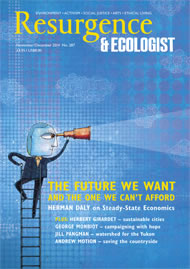When my parents purchased a singing bowl many years ago, I remember being quite disappointed that it didn’t sing actual songs. This disappointment quickly gave way to a curiosity and respect for the noises that it did make. Stroking around its rim with a small wooden stick, or ‘wand’, one could excite the bowl to produce a peaceful hum that slowly grew to fill the room. I have always retained a certain intrigue for singing bowls, and so I was excited to come across something claiming to be “the complete singing bowl book”.
Frank Perry is one of the leading practitioners of singing bowls, as well as a successful musician, artist and healer. Having previously played as a jazz percussionist in several bands, he has subsequently used his solo work to explore spiritual interests. It was in this way that he became involved with singing bowls. Although doubts remain over their precise history and use, such bowls have long been associated with meditation and pre-Buddhist shamanic traditions dating back thousands of years.
Himalayan Sound Revelations is a readable account of the author’s experiences with singing bowls. It covers not only bowls and the techniques used to play them, but also Chinese bells, and other traditional instruments such as the drilbu (Tibetan handbell) and the ting-sha (small, paired cymbals). Perry also draws inspiration from his own spiritual beliefs relating to esoteric Christianity, chakras, astrology, and a range of other elements. In the first chapter, he explains how a Tibetan “spirit helper”, who lived thousands of years ago, visited him and imparted traditional wisdom about the bowls. Not all his inspiration, however, comes from such unusual sources. He goes on to direct the reader to a video on YouTube featuring an acclaimed Zen master.
The book contains an admirable level of historical investigation. Tracing the origin of bells, for example, Perry takes us to China, where the earliest civilisations used bells for purposes both sacred and profane. The oldest tuned bells to have been excavated date back to around 2000 BCE. Wind bells, Perry explains, were once hung outside homes and temples as protection from evil spirits.
Despite the depth of Perry’s research, one of the book’s weaknesses, for me, is the extent to which his own unique views on spirituality and esoteric religion become entangled with the main subject matter. When working with the four elements (earth, water, air and fire), for example, he tells us that “we must be ever mindful that these [elements] are governed by angels and that these angels are God’s servants.” “We can ask the Lord”, he continues, “to send his angels … as we stroke the bowl.” He makes these statements in such a matter-of-fact way that it becomes difficult to ascertain where his own opinions end, and where the true story of the singing bowl begins.
While Himalayan Sound Revelations is undoubtedly a thought-provoking book, it is, in some ways, perhaps more revealing of the inner workings of the author than it is of its subject. Although it contains a wealth of valuable information on the sacred instruments of the Tibetan region, it is not, as it claims to be, the “complete” singing bowl book, but rather the story of one man’s love affair with these intriguing objects. In particular, it tells how singing bowls helped the author explore different aspects of sound, healing and spiritual development. Whether or not you agree with all of Frank Perry’s ideas, it is clear that singing bowls can provide an ideal space for contemplation.







